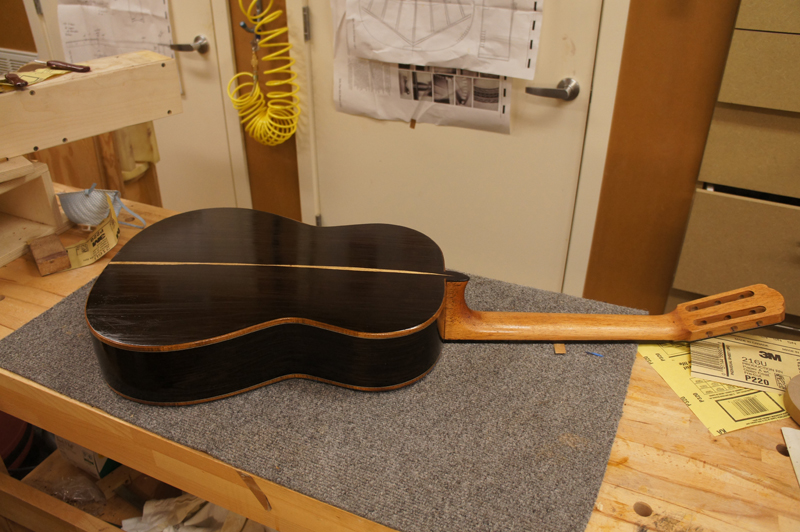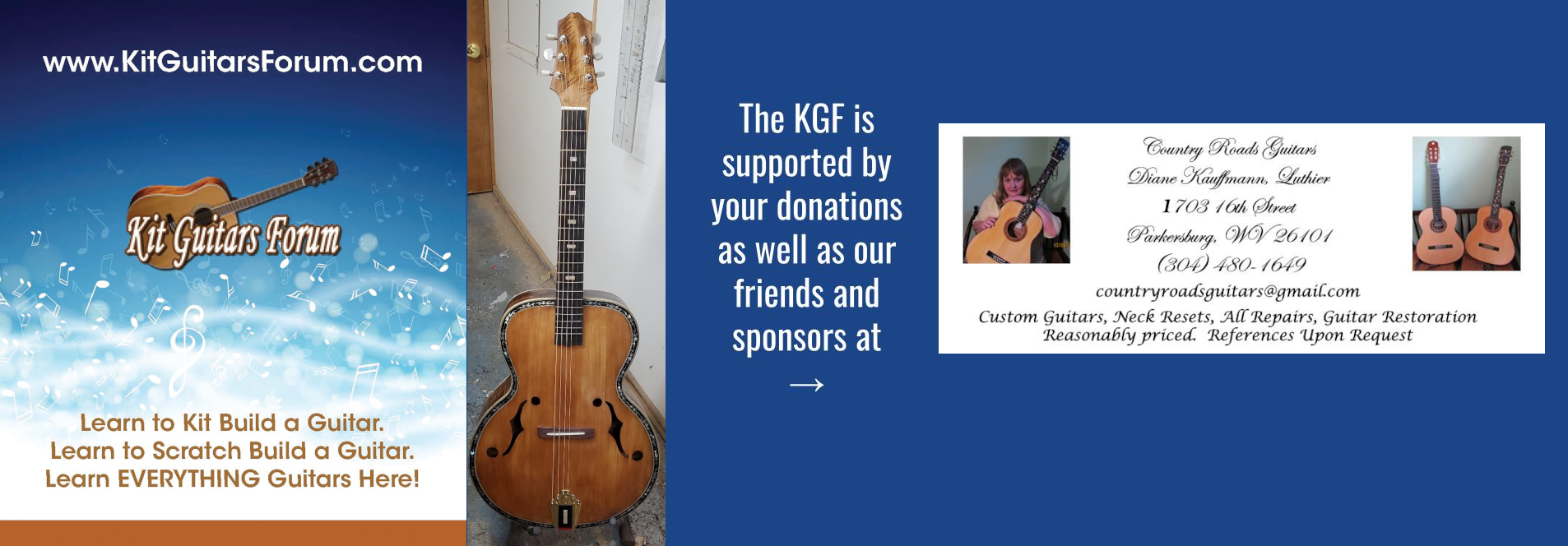Classical guitar Body FP finished
-
justrfb
- Posts: 217
- Joined: Wed Aug 22, 2012 8:17 am
- Location: North Jersey
Re: Closed up my Classical guitar today.
Nice work... Looks beautiful.
Sincerely,
Rich
Sincerely,
Rich
-
naccoachbob
- Posts: 477
- Joined: Thu Dec 03, 2009 9:25 am
- Location: Nacogdoches, Tx
Re: Closed up my Classical guitar today.
John, good work.
Question. On bracing the back of a Classical, have you thought of going even lighter? Even though it's 3 braces, the body is more like a tight-waisted OM isn't it? I'm getting into the "responsive back" mode lately, so I'm curious as to what effect(s) it might have to thin the braces and maybe lower them some as well.
Bob
Question. On bracing the back of a Classical, have you thought of going even lighter? Even though it's 3 braces, the body is more like a tight-waisted OM isn't it? I'm getting into the "responsive back" mode lately, so I'm curious as to what effect(s) it might have to thin the braces and maybe lower them some as well.
Bob
-
johnnparchem
- Posts: 2354
- Joined: Sat Apr 10, 2010 10:50 pm
- Location: Seattle
- Contact:
Re: Closed up my Classical guitar today.
Trevor Gore says a non-live back would be four braces 20mm height and 10 wide.
I think I have somewhat of a live back, I can certainly see it when I do a spectrum graph of tapping the top. I can also hear its contribution go away by muffling the back and tapping. So the question would be do I want it more live. Trevor Gore has a live back design where he severely scallops the center of the lower ladder brace and adds some radial tone bar like braces on the diagonals formed between the lower brace and the center strip.
From what I read to have an effective live back it is not just lighter braces and thinner back but you need to be able to tune the back to work well with the top. A live back coupling of the back to the top can do just as much to subtract from the tone as you are looking to add to the tone. The plates can fight each other. Basically if you are vibrating the back you are taking energy from the top. Thus it is important that you get some value for that energy in increased tone as opposed to damping.
When I have the guitar finished with all of the hardware I will tune the back for good coupling to the top by shaving the lower brace if needed. By tune I would be looking to lower its resonance a bit if I need to pull it away from a whole note. I am a bit stiff now so I know that I will not have to raise the resonant frequency of the back.
I think I have somewhat of a live back, I can certainly see it when I do a spectrum graph of tapping the top. I can also hear its contribution go away by muffling the back and tapping. So the question would be do I want it more live. Trevor Gore has a live back design where he severely scallops the center of the lower ladder brace and adds some radial tone bar like braces on the diagonals formed between the lower brace and the center strip.
From what I read to have an effective live back it is not just lighter braces and thinner back but you need to be able to tune the back to work well with the top. A live back coupling of the back to the top can do just as much to subtract from the tone as you are looking to add to the tone. The plates can fight each other. Basically if you are vibrating the back you are taking energy from the top. Thus it is important that you get some value for that energy in increased tone as opposed to damping.
When I have the guitar finished with all of the hardware I will tune the back for good coupling to the top by shaving the lower brace if needed. By tune I would be looking to lower its resonance a bit if I need to pull it away from a whole note. I am a bit stiff now so I know that I will not have to raise the resonant frequency of the back.
-
naccoachbob
- Posts: 477
- Joined: Thu Dec 03, 2009 9:25 am
- Location: Nacogdoches, Tx
Re: Closed up my Classical guitar today.
Ok, I got it now. I didn't know that it was already working that way. Great info. And yes, the "tuning" of the back to the top is something I've not heard much about as far as someone explaining it other than Somogyi saying something about 2-3 tones different (IIRC). He may have said lower. Thanks for passing that on.
-
johnnparchem
- Posts: 2354
- Joined: Sat Apr 10, 2010 10:50 pm
- Location: Seattle
- Contact:
Re: Closed up my Classical guitar today.
He probably set 2-3 semitones higher. Trevor say 4 semitones. The backs generally have a higher resonate frequency than the top because they are stiffer. Like top sort of 180-190 hz F#G ish and the back around A# ish around 235.naccoachbob wrote:Ok, I got it now. I didn't know that it was already working that way. Great info. And yes, the "tuning" of the back to the top is something I've not heard much about as far as someone explaining it other than Somogyi saying something about 2-3 tones different (IIRC). He may have said lower. Thanks for passing that on.
-
johnnparchem
- Posts: 2354
- Joined: Sat Apr 10, 2010 10:50 pm
- Location: Seattle
- Contact:
Re: Closed up my Classical guitar today.
I have not posted in a bit as I have had a hectic schedule having to travel to Beijing to give a talk. But any way in the mean time, I did install the binding and the purflings, not without a few issues. Live and learn ...
Working with a classical built with a Spanish neck requires that the area around the neck has to be done by hand with knifes and chisels. I did OK, with the sap wood strip up the center of the back I did not want to cut the binding channel where the back wood became the heal cap. Rather I cut it in a bit much like a violin back. To accomplish this I drew out the cut I wanted with a scalpel and treated it a bit like an inlay using a mini mill grinder. The tip on the bit only allowed me to go 1/16 inch or so deep but I was able to get the start on the channels I wanted and used a 2mm chisel for the remainder. Normally I would use a razor saw and just cut across to open the channel. On the top I just used a scalpel and a 2mm chisel to cut the channel under the fret board.
The two real problems I had:
When routing the back I was a little loose where I started a cut and tore out a hunk of back almost to the end of the kerfed linings. I cleaned up the tearout and carved a matching patch from a cutoff that was right next to the tear out ( save those cut offs) See if you can find it. Once you see it, it does not go away, it does not look too bad.
The other is I decided that a lining installed on the back was too dark and not a match for its neighbor. This was the only binding on the guitar so I removed the it. Unfortunately I goofed up the miter on the end strip. I was trying to patch a bit of the purfling when I decided to chisel out more of the binding to make a bigger patch when it dawned on me that it was just as easy to remove the whole binding. I have a 1mm chisel that I made out of a 2mm chisel. After using a scalpel to separate the binding from the rims it was easy to just chisel out the binding cleanly and install a new one.
Give that this is a classical I took the time to use a spectrum analyzer to get the resonance frequencies close before I routed the binding. Now they are high but with the bridge glued on the first resonance should drop to about 100 and the main resonance should be about 102 Hz. That is my target anyway. I also have mapped the entire top with a magic-probe.
The bindings are Australian Blackwood with bwb side purflings. I have a brown white brown purfling for the top to match the rosette.
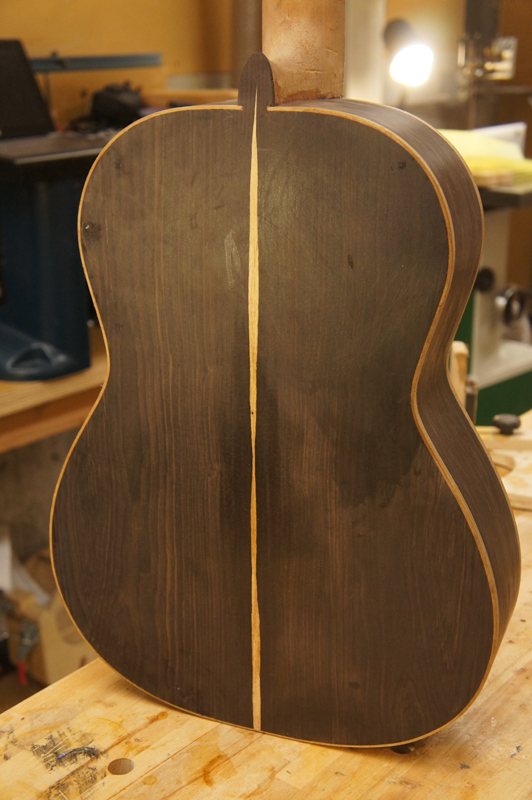
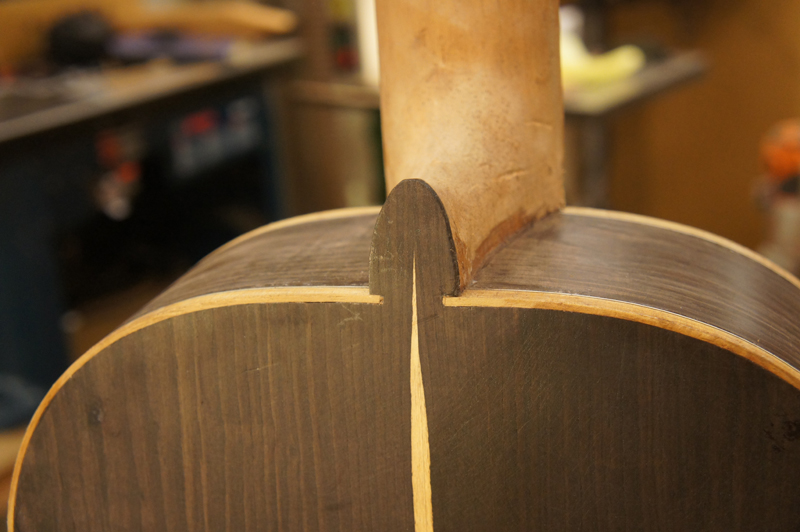
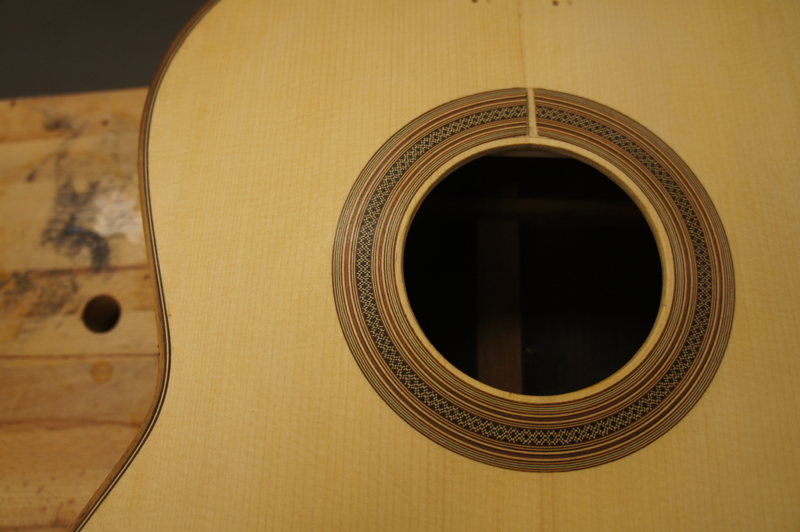
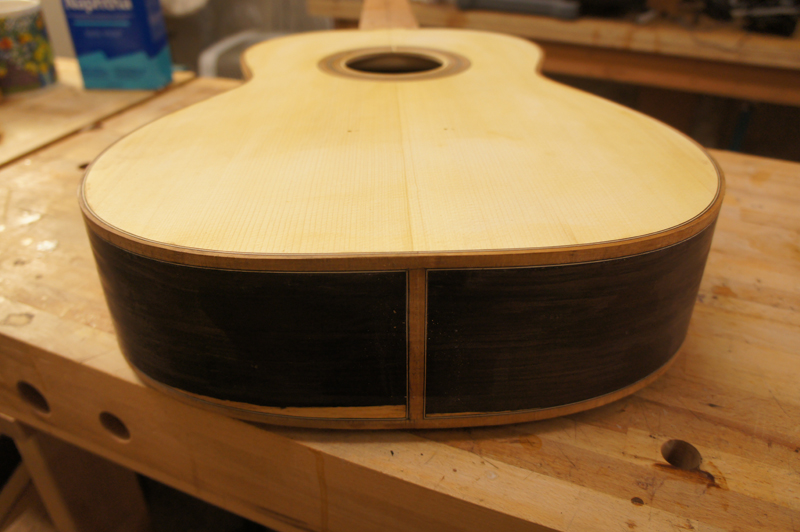
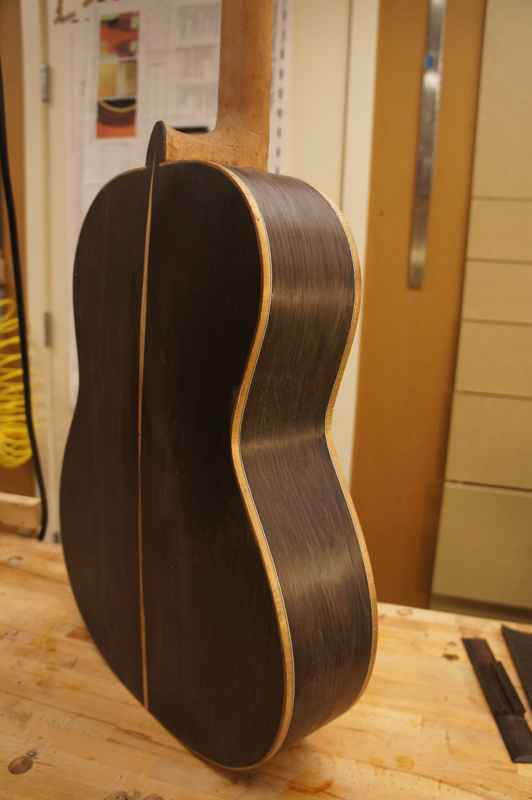
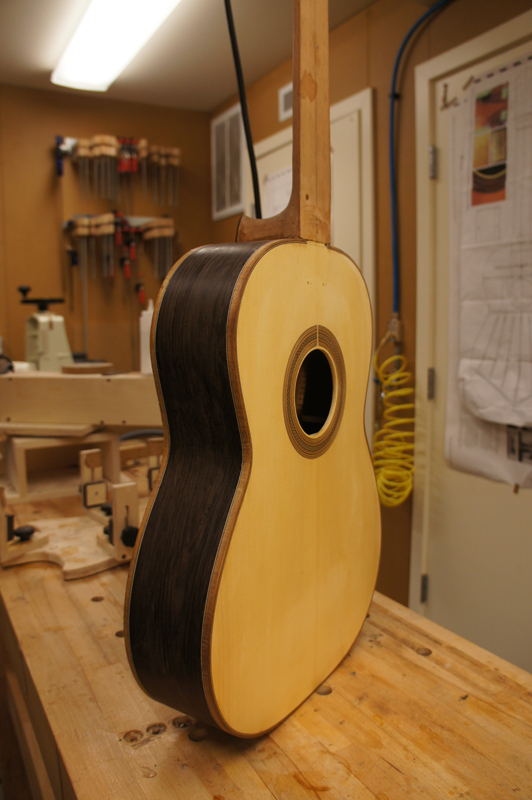
On to finishing the neck and fret board!
Working with a classical built with a Spanish neck requires that the area around the neck has to be done by hand with knifes and chisels. I did OK, with the sap wood strip up the center of the back I did not want to cut the binding channel where the back wood became the heal cap. Rather I cut it in a bit much like a violin back. To accomplish this I drew out the cut I wanted with a scalpel and treated it a bit like an inlay using a mini mill grinder. The tip on the bit only allowed me to go 1/16 inch or so deep but I was able to get the start on the channels I wanted and used a 2mm chisel for the remainder. Normally I would use a razor saw and just cut across to open the channel. On the top I just used a scalpel and a 2mm chisel to cut the channel under the fret board.
The two real problems I had:
When routing the back I was a little loose where I started a cut and tore out a hunk of back almost to the end of the kerfed linings. I cleaned up the tearout and carved a matching patch from a cutoff that was right next to the tear out ( save those cut offs) See if you can find it. Once you see it, it does not go away, it does not look too bad.
The other is I decided that a lining installed on the back was too dark and not a match for its neighbor. This was the only binding on the guitar so I removed the it. Unfortunately I goofed up the miter on the end strip. I was trying to patch a bit of the purfling when I decided to chisel out more of the binding to make a bigger patch when it dawned on me that it was just as easy to remove the whole binding. I have a 1mm chisel that I made out of a 2mm chisel. After using a scalpel to separate the binding from the rims it was easy to just chisel out the binding cleanly and install a new one.
Give that this is a classical I took the time to use a spectrum analyzer to get the resonance frequencies close before I routed the binding. Now they are high but with the bridge glued on the first resonance should drop to about 100 and the main resonance should be about 102 Hz. That is my target anyway. I also have mapped the entire top with a magic-probe.
The bindings are Australian Blackwood with bwb side purflings. I have a brown white brown purfling for the top to match the rosette.






On to finishing the neck and fret board!
You do not have the required permissions to view the files attached to this post.
-
Kevin Sjostrand
- Posts: 3727
- Joined: Sat Feb 09, 2008 8:06 pm
- Location: Visalia, CA
Re: Closed up my Classical guitar today.
I can't find it.
How do you do the testing to get the squiggly lines?
How was Bejing?
Kevin
How do you do the testing to get the squiggly lines?
How was Bejing?
Kevin
-
johnnparchem
- Posts: 2354
- Joined: Sat Apr 10, 2010 10:50 pm
- Location: Seattle
- Contact:
Re: Closed up my Classical guitar today.
Kevin, I used Visual Analyzer http://www.sillanumsoft.org/ set up like I found here http://www.anzlf.com/viewtopic.php?f=1&t=3696&p=61874 on a PC with an attached microphone. I am not sure I am doing anything useful with it as yet but at this time I can document each of my instruments and help study the concepts that are in Gore\Gilet books.
Beijing was OK, I love traveling as a tourist with my family, not so much traveling for work. It was interesting to see the formal rules around very high level government bureaucrats as I was the VIP of the opening of the China chapter of an international standards organization and met with quite a few in private meetings. Luckily I had a really good translator, that would fill in what I would say with all of the respectful things I should have said.
Beijing was OK, I love traveling as a tourist with my family, not so much traveling for work. It was interesting to see the formal rules around very high level government bureaucrats as I was the VIP of the opening of the China chapter of an international standards organization and met with quite a few in private meetings. Luckily I had a really good translator, that would fill in what I would say with all of the respectful things I should have said.
-
johnnparchem
- Posts: 2354
- Joined: Sat Apr 10, 2010 10:50 pm
- Location: Seattle
- Contact:
Re: Completed construction of my classical guitar in final p
I am finally in final prep sanding of this classical guitar. This is my 11th instrument; you would think I could glue on a fret board. Yikes! I prepared the fret board for gluing planning it to the correct thickness . This meant planeing my 8mm board to between 6 and 5 mm. I made a caul out of 3/4 plywood and test clamped the fret board all looked great. I put a thin layer of LMI instrument glue and clamped the fret board with a whole lot of cam clamps against a full size caul. I came back 15 minutes later to do clean up and found that the fret board had warped so much that the edges were actually lifted a touch against the caul and the clamps. Yikes.
I used a repair heat blanket I have to remove the fret boards. It was very wrapped. I used the same blanket and caul and clamps to heat and flatten the fret board. I cycled the heat about three times over a couple of days and ended up with a flat fret board again. To avoid warping it again I used structural epoxy to glue on the fret board.
So today I started clean up work. I am crossing my fingers still waiting for the first dent or scratch in the top. I am about at the point where I can cover the top through the zpoxy pore fill.
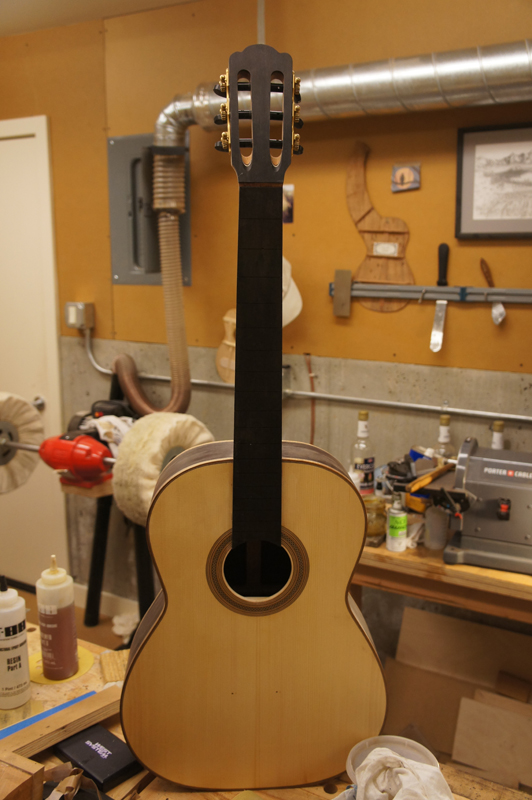
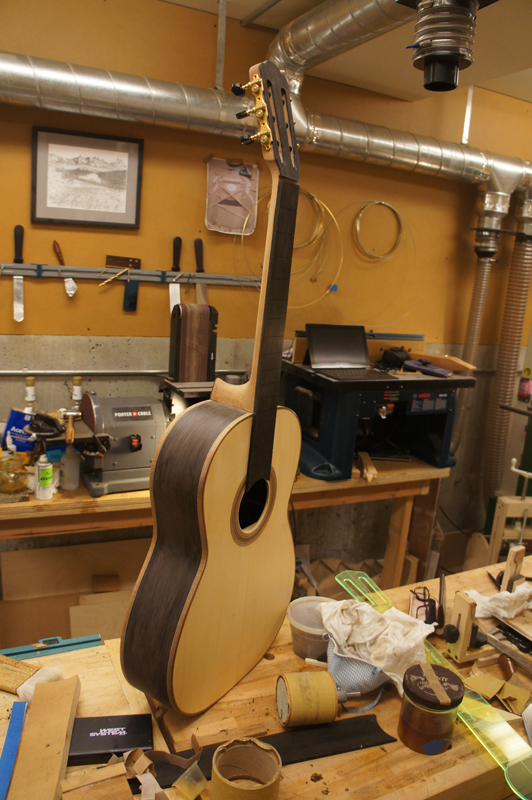
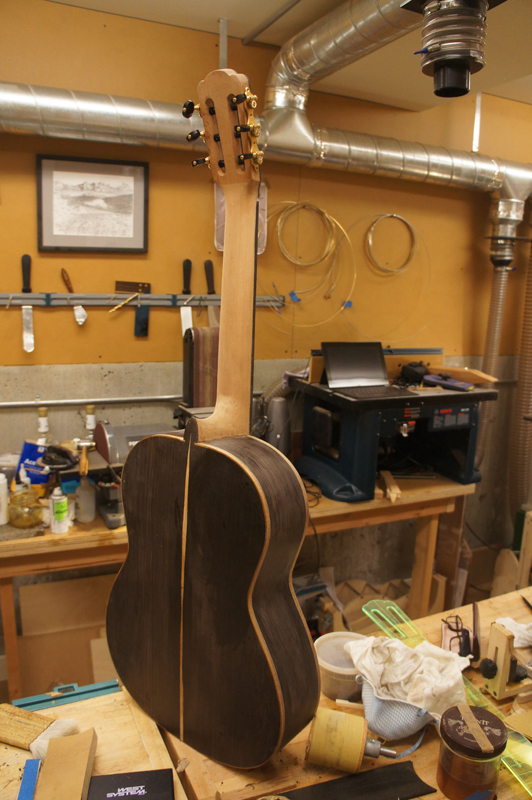
I used a repair heat blanket I have to remove the fret boards. It was very wrapped. I used the same blanket and caul and clamps to heat and flatten the fret board. I cycled the heat about three times over a couple of days and ended up with a flat fret board again. To avoid warping it again I used structural epoxy to glue on the fret board.
So today I started clean up work. I am crossing my fingers still waiting for the first dent or scratch in the top. I am about at the point where I can cover the top through the zpoxy pore fill.



Last edited by johnnparchem on Thu Jul 04, 2013 5:52 pm, edited 1 time in total.
-
johnnparchem
- Posts: 2354
- Joined: Sat Apr 10, 2010 10:50 pm
- Location: Seattle
- Contact:
Re: Completed construction of my classical guitar in final p
First coat of z-poxy. I tried something different this time. Before doing the back and sides I ran a clean line of z-poxy on all of the light would and the side purflings. The rosewood gives off a lot of color.
